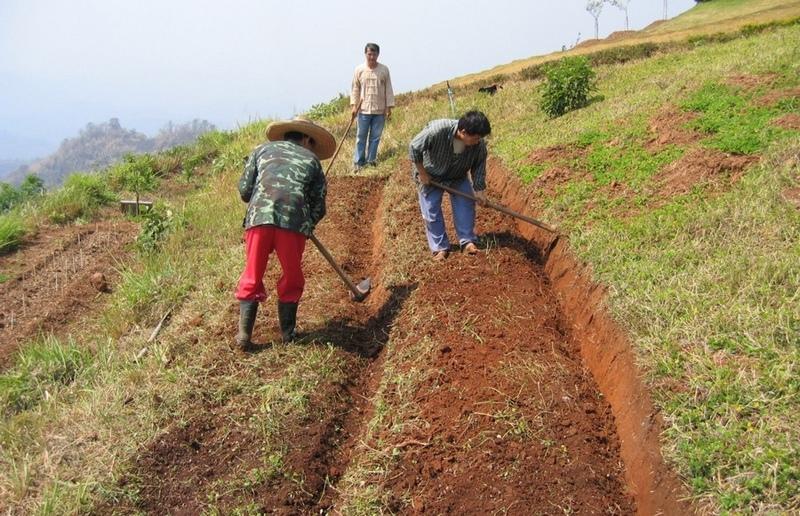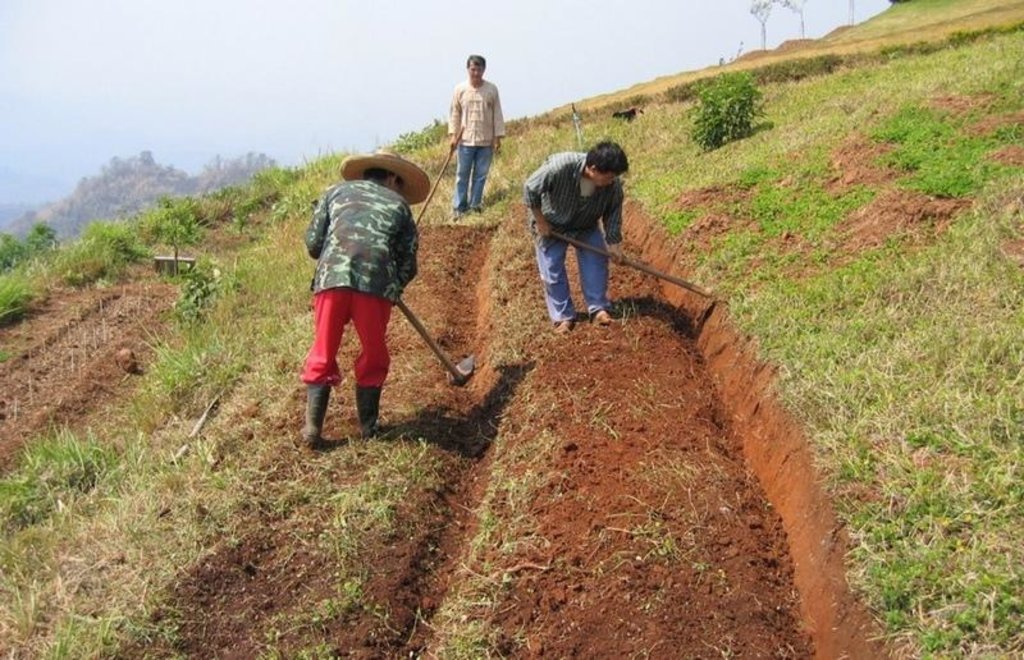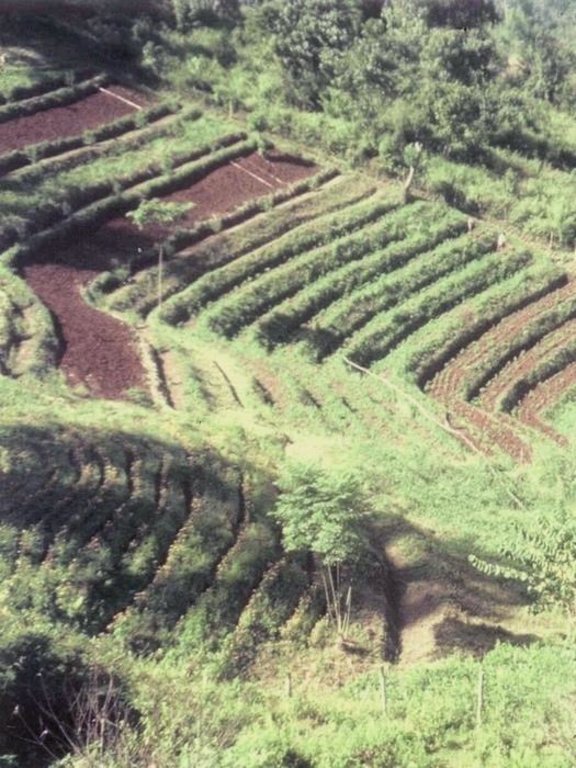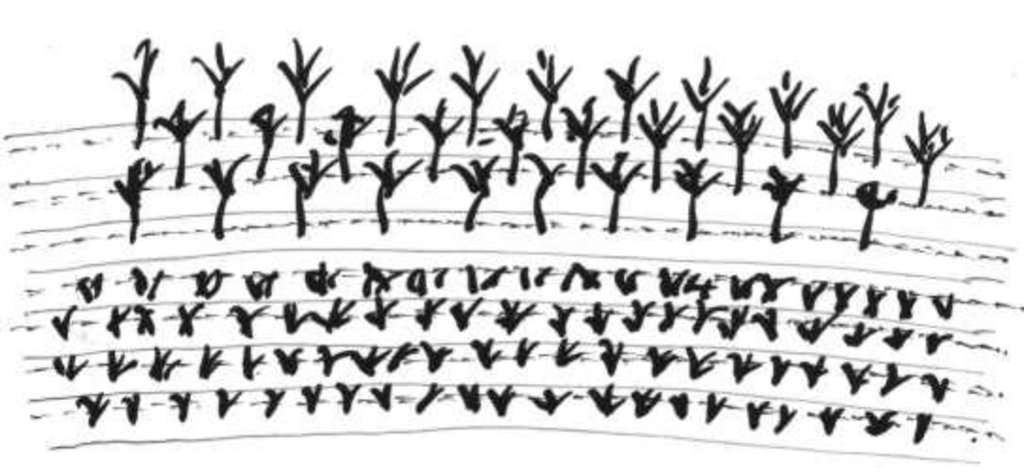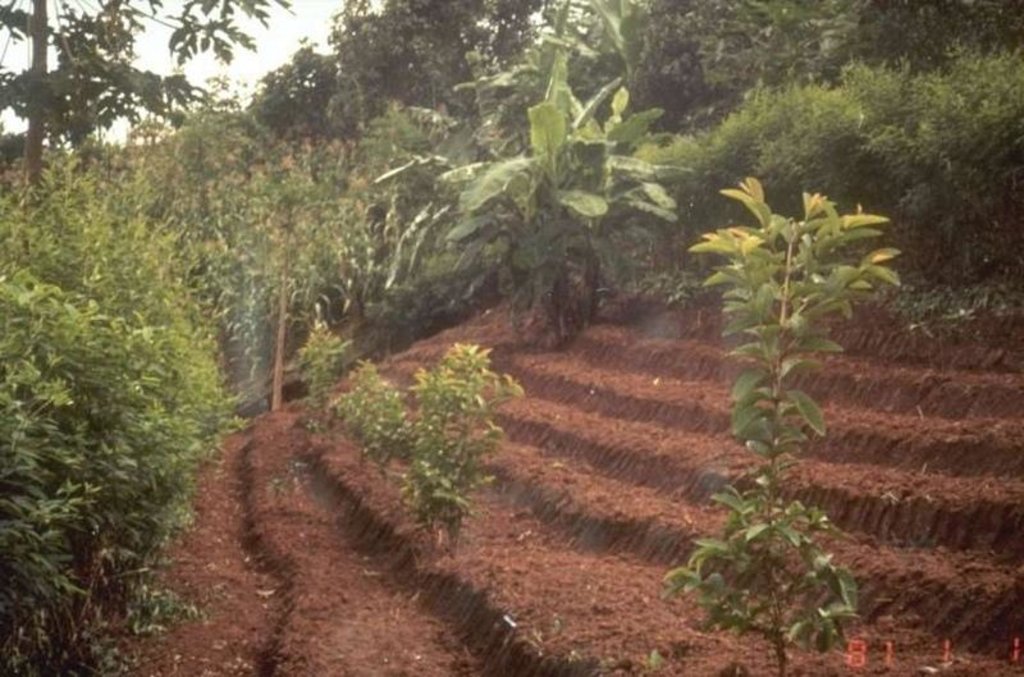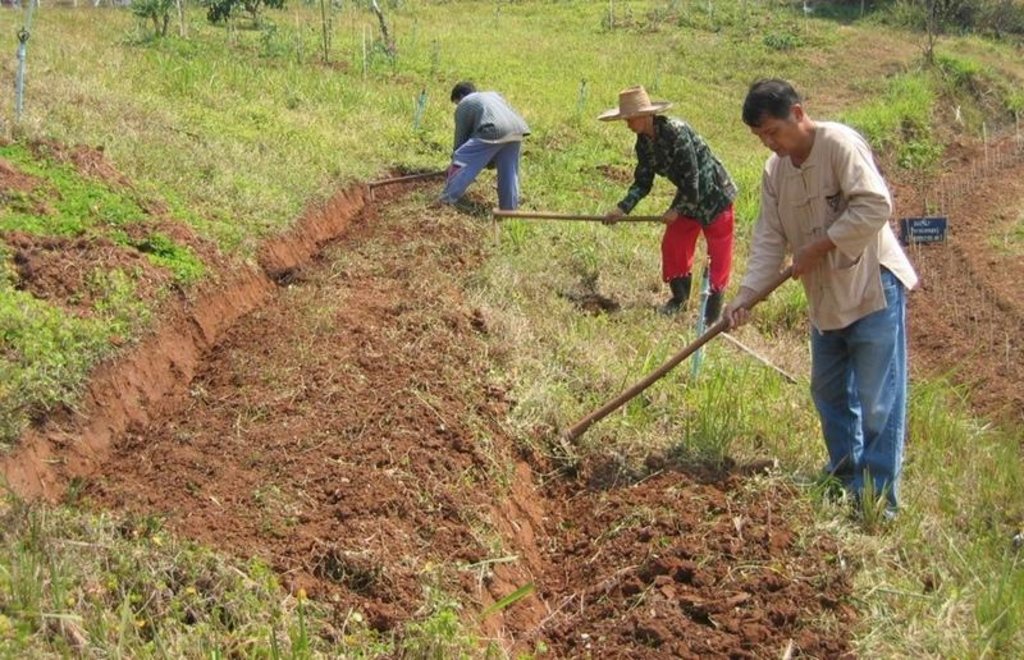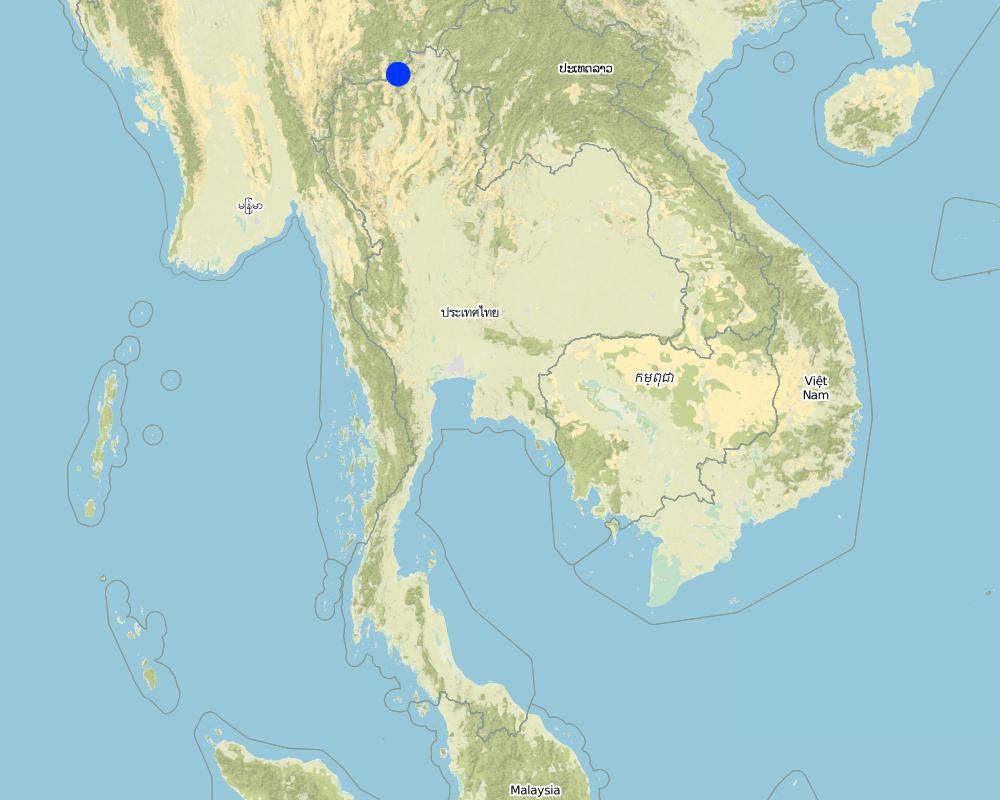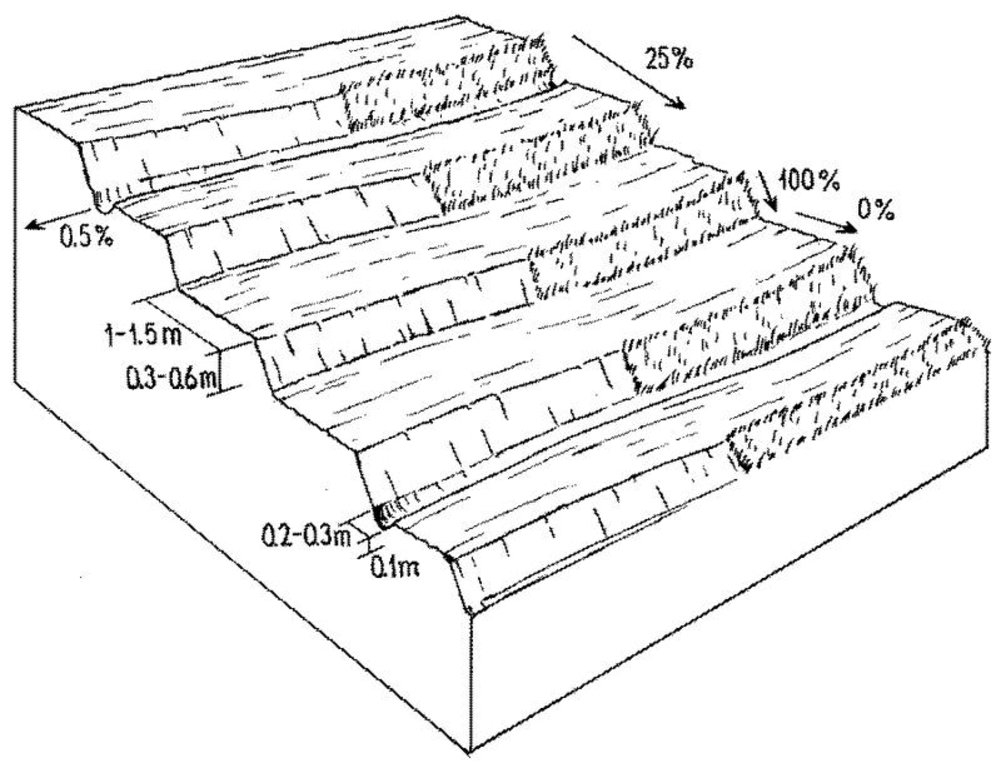Small level bench terraces [Thaïlande]
- Création :
- Mise à jour :
- Compilateur : Samran Sombatpanit
- Rédacteur : –
- Examinateurs : Fabian Ottiger, Alexandra Gavilano
Khan ban dai din khanard lek (Thai)
technologies_1404 - Thaïlande
Voir les sections
Développer tout Réduire tout1. Informations générales
1.2 Coordonnées des personnes-ressources et des institutions impliquées dans l'évaluation et la documentation de la Technologie
Spécialiste GDT:
Cheewinkuntong Wichai
Thaïlande
Nom du projet qui a facilité la documentation/ l'évaluation de la Technologie (si pertinent)
Book project: where the land is greener - Case Studies and Analysis of Soil and Water Conservation Initiatives Worldwide (where the land is greener)Nom du ou des institutions qui ont facilité la documentation/ l'évaluation de la Technologie (si pertinent)
World Association of Soil and Water Conservation (WASWC) - Chine1.3 Conditions relatives à l'utilisation par WOCAT des données documentées
Le compilateur et la(les) personne(s) ressource(s) acceptent les conditions relatives à l'utilisation par WOCAT des données documentées:
Oui
2. Description de la Technologie de GDT
2.1 Courte description de la Technologie
Définition de la Technologie:
Terraces with narrow beds, used for growing tea, coffee, and horticultural crops on hillsides cleared from forests.
2.2 Description détaillée de la Technologie
Description:
The terraces described in this case study from northern Thailand are found on hilly slopes with deep soils. The climate is humid and tropical, with 1,700-2,000 mm of rainfall annually. The main aim of the terraces is to facilitate cultivation of tea or coffee on sloping land: erosion control is secondary. Coffee and tea, as well as flowers and vegetables, are good alternatives to opium poppies - which it is government policy to eradicate.
Purpose of the Technology: After clearing natural and secondary forests by slash and burn, terraces are aligned by eye - and constructed by hoe. The width of the bed is 1.0-1.5 m depending on slope, though there are no specific technical guidelines. The length of each terrace can be up to 25 m. Down the slope, after every 3-4 terraces, there are lateral drainage channels, approximately 20-30 cm wide and 10 cm deep. Situated at the foot of a riser, each channel has a gradient of 0.5% or less. Excess water - some of which cascades over the terrace risers, with some draining through the soil - is discharged through these channels, generally to natural waterways. The risers are steep, with a slope of above 100%, and without a defined lip.
Establishment / maintenance activities and inputs: Natural grass cover develops on the risers: this is cut back by hand hoe or machete, or completely removed. The grass is often burned. After harvest (of annual crops), the land is left until immediately before the next rainy season. The terraces at this stage are covered by weeds and grasses. Land is then tilled by hoe. The weeds and grasses are removed and heaped in piles outside the cropped area. They are not composted or used for mulching - and here an opportunity is missed. Where soil fertility is a problem, chemical fertilizers are used. Maintenance includes building up/repairing of risers and levelling of terrace beds as required.
Natural / human environment: The technology was pioneered, and continues to be practiced, by refugee immigrants from China looking for new areas to start farming. These immigrants first came in the 1950s, and cultivated simply through slash and burn techniques. During the 1970s they visited relatives in Taiwan and brought back the idea of small terraces. Originally they settled illegally, but eventually they were given official permission to stay. However, official title deeds to their land have not yet been allocated.
2.3 Photos de la Technologie
2.5 Pays/ région/ lieux où la Technologie a été appliquée et qui sont couverts par cette évaluation
Pays:
Thaïlande
Région/ Etat/ Province:
ChiangMai
Autres spécifications du lieu:
Amphur Mae Fa Luang
Spécifiez la diffusion de la Technologie:
- répartie uniformément sur une zone
S'il n'existe pas d'informations exactes sur la superficie, indiquez les limites approximatives de la zone couverte:
- 1-10 km2
Commentaires:
Total area covered by the SLM Technology is 5 km2.
This practice has been done by tribal people such as E-kaw, Lahu, Lisu, Mien, Khin, Thai Yai, Haw Chinese, H'mong
Map
×2.6 Date de mise en œuvre de la Technologie
Si l'année précise est inconnue, indiquez la date approximative: :
- il y a moins de 10 ans (récemment)
2.7 Introduction de la Technologie
Spécifiez comment la Technologie a été introduite: :
- grâce à l'innovation d'exploitants des terres
Commentaires (type de projet, etc.) :
Taiwan.
3. Classification de la Technologie de GDT
3.1 Principal(aux) objectif(s) de la Technologie
- améliorer la production
- réduire, prévenir, restaurer les terres dégradées
- créer un impact économique positif
3.2 Type(s) actuel(s) d'utilisation des terres, là où la Technologie est appliquée

Terres cultivées
- Cultures annuelles
- Cultures pérennes (non ligneuses)
- Plantations d’arbres ou de buissons
- vegetables, flowers
Plantations d'arbres et d'arbustes - Précisez les cultures:
- café, cultivé en plein champ
- thé
Nombre de période de croissance par an: :
- 2
Précisez:
Longest growing period in days: 150 Longest growing period from month to month: Dec - Apr
Commentaires:
Major land use problems (compiler’s opinion): - soil erosion on cultivated hillsides
- practical difficulties in tending tea, coffee, vegetables and flowers on sloping land: farming is much easier on levelled land
- Lacking of land ownership (The whole area is reserved forest.)
- Low price of agricultural produce.
Major land use problems (land users’ perception): 1. Lacking of land ownership. 2. Landusers do not have Thai citizenship; less than 20% have ID cards (not citizenship).
Forest: before SWC measures
3.4 Approvisionnement en eau
Approvisionnement en eau des terres sur lesquelles est appliquée la Technologie:
- pluvial
3.5 Groupe de GDT auquel appartient la Technologie
- mesures en travers de la pente
- dérivation et drainage de l'eau
3.6 Mesures de GDT constituant la Technologie

pratiques végétales
- V2: Herbes et plantes herbacées pérennes

structures physiques
- S1: Terrasses
Commentaires:
Main measures: structural measures
Secondary measures: vegetative measures
3.7 Principaux types de dégradation des terres traités par la Technologie

érosion hydrique des sols
- Wt: perte de la couche superficielle des sols (couche arable)/ érosion de surface

dégradation chimique des sols
- Cn: baisse de la fertilité des sols et réduction du niveau de matière organique (non causée par l’érosion)

dégradation hydrique
- Ha: aridification
Commentaires:
Main type of degradation addressed: Wt: loss of topsoil / surface erosion, Cn: fertility decline and reduced organic matter content, Ha: aridification
Main causes of degradation: deforestation / removal of natural vegetation (incl. forest fires), Lack of enforcement of legislation or authority
Secondary causes of degradation: other human induced causes (specify) (Agricultural activities), other natural causes (avalanches, volcanic eruptions, mud flows, highly susceptible natural resources, extreme topography, etc.) specify
3.8 Prévention, réduction de la dégradation ou réhabilitation des terres dégradées
Spécifiez l'objectif de la Technologie au regard de la dégradation des terres:
- prévenir la dégradation des terres
4. Spécifications techniques, activités, intrants et coûts de mise en œuvre
4.1 Dessin technique de la Technologie
Spécifications techniques (associées au dessin technique):
Layout of small level bench terraces. After every third or fourth terrace a lateral drainage channel is built. Later, protective grass cover is established on the risers (right).
Technical knowledge required for field staff / advisors: moderate
Technical knowledge required for land users: moderate
Main technical functions: control of dispersed runoff: retain / trap, reduction of slope angle, reduction of slope length
Secondary technical functions: control of concentrated runoff: impede / retard, increase of infiltration, increase / maintain water stored in soil
Vegetative measure: grass on risers (optional)
Vegetative material: G : grass
Vegetative measure: Vegetative material: G : grass
Vegetative measure: Vegetative material: G : grass
Vegetative measure: Vegetative material: G : grass
Terrace: bench level
Vertical interval between structures (m): 0.4
Spacing between structures (m): 0.3
Height of bunds/banks/others (m): 0.4
Width of bunds/banks/others (m): 1.5
Length of bunds/banks/others (m): 25
Structural measure: drainage channels
Depth of ditches/pits/dams (m): 0.1
Width of ditches/pits/dams (m): .02 - .3
Construction material (earth): It is the earth dug in situ.
Lateral gradient along the structure: 0%
Vegetation is used for stabilisation of structures.
Auteur:
Mats Gurtner
4.2 Informations générales sur le calcul des intrants et des coûts
autre/ monnaie nationale (précisez):
Baht
Indiquez le taux de change des USD en devise locale, le cas échéant (p.ex. 1 USD = 79.9 réal brésilien): 1 USD = :
37,0
Indiquez le coût salarial moyen de la main d'œuvre par jour:
2.16
4.3 Activités de mise en place/ d'établissement
| Activité | Calendrier des activités (saisonnier) | |
|---|---|---|
| 1. | Layout is simply by eye and best judgment. | |
| 2. | Work begins on the lower part of the slope, and then progresses uphill. | |
| 3. | Farmers cut into the hillside with hoes and drag the soil down to formthe risers and level the terrace beds. | |
| 4. | Risers are then stabilised/compacted by hoe. |
4.4 Coûts et intrants nécessaires à la mise en place
| Spécifiez les intrants | Unité | Quantité | Coûts par unité | Coût total par intrant | % du coût supporté par les exploitants des terres | |
|---|---|---|---|---|---|---|
| Main d'œuvre | Labour | ha | 1,0 | 270,0 | 270,0 | 100,0 |
| Equipements | Tools | ha | 1,0 | 5,0 | 5,0 | 100,0 |
| Coût total de mise en place de la Technologie | 275,0 | |||||
| Coût total de mise en place de la Technologie en dollars américains (USD) | 7,43 | |||||
Commentaires:
Duration of establishment phase: 12 month(s)
4.5 Activités d'entretien/ récurrentes
| Activité | Calendrier/ fréquence | |
|---|---|---|
| 1. | Weeds and grasses are removed and piled outside the cropping area. | |
| 2. | Land is prepared through tillage by hoe. | |
| 3. | Risers are built up/repaired where necessary. | |
| 4. | Terrace beds may need levelling. |
4.6 Coûts et intrants nécessaires aux activités d'entretien/ récurrentes (par an)
| Spécifiez les intrants | Unité | Quantité | Coûts par unité | Coût total par intrant | % du coût supporté par les exploitants des terres | |
|---|---|---|---|---|---|---|
| Main d'œuvre | Labour | ha | 1,0 | 45,0 | 45,0 | 100,0 |
| Equipements | Tools | ha | 1,0 | 45,0 | 45,0 | 100,0 |
| Coût total d'entretien de la Technologie | 90,0 | |||||
| Coût total d'entretien de la Technologie en dollars américains (USD) | 2,43 | |||||
Commentaires:
Clearing of forest is not included in the cost calculations. This calculation is based on a typical slope of approximately 20%, with risers of 0.2 m in height and beds 1.0 m wide. Maintenance costs include basic land preparation (for annual crops) or weeding etc for perennial crops.
4.7 Facteurs les plus importants affectant les coûts
Décrivez les facteurs les plus importants affectant les coûts :
The slope factor affects most because it will require longer time to construct.
5. Environnement naturel et humain
5.1 Climat
Précipitations annuelles
- < 250 mm
- 251-500 mm
- 501-750 mm
- 751-1000 mm
- 1001-1500 mm
- 1501-2000 mm
- 2001-3000 mm
- 3001-4000 mm
- > 4000 mm
Spécifications/ commentaires sur les précipitations:
Average 1600-1800 mm
Zone agro-climatique
- humide
Thermal climate class: tropics
5.2 Topographie
Pentes moyennes:
- plat (0-2 %)
- faible (3-5%)
- modéré (6-10%)
- onduleux (11-15%)
- vallonné (16-30%)
- raide (31-60%)
- très raide (>60%)
Reliefs:
- plateaux/ plaines
- crêtes
- flancs/ pentes de montagne
- flancs/ pentes de colline
- piémonts/ glacis (bas de pente)
- fonds de vallée/bas-fonds
Zones altitudinales:
- 0-100 m
- 101-500 m
- 501-1000 m
- 1001-1500 m
- 1501-2000 m
- 2001-2500 m
- 2501-3000 m
- 3001-4000 m
- > 4000 m
Commentaires et précisions supplémentaires sur la topographie:
Slopes on average: Also steep (ranked 3)
Soil fertility: Low (ranked 1) and very low (ranked 2)
Soil drainage/infiltration: Medium (ranked 1, good drainage though being cleyey soil) and good (ranked 2)
Soil water storage capacity: Medium and low (both ranked 1)
5.3 Sols
Profondeur moyenne du sol:
- très superficiel (0-20 cm)
- superficiel (21-50 cm)
- modérément profond (51-80 cm)
- profond (81-120 cm)
- très profond (>120 cm)
Texture du sol (de la couche arable):
- moyen (limoneux)
Matière organique de la couche arable:
- faible (<1%)
5.6 Caractéristiques des exploitants des terres appliquant la Technologie
Orientation du système de production:
- subsistance (auto-approvisionnement)
- commercial/ de marché
Revenus hors exploitation:
- 10-50% de tous les revenus
Niveau relatif de richesse:
- pauvre
- moyen
Niveau de mécanisation:
- travail manuel
- traction animale
Indiquez toute autre caractéristique pertinente des exploitants des terres:
Population density: < 10 persons/km2
6% of the land users are rich and own 35% of the land.
24% of the land users are average wealthy and own 40% of the land.
60% of the land users are poor and own 20% of the land.
10% of the land users are poor and own 5% of the land.
Off-farm income specification: farmers spend much time as farm labourers on other farms or in food processing factories - and some have jobs at construction sites, for example road building
Level of mechanization: Manual work (ranked 1) and animal traction (ranked 2)
Market orientation: Commercial/market (ranked 1, tea, coffee, vegetable and flower production) and subsistence (ranked 2)
5.7 Superficie moyenne des terres utilisées par les exploitants des terres appliquant la Technologie
- < 0,5 ha
- 0,5-1 ha
- 1-2 ha
- 2-5 ha
- 5-15 ha
- 15-50 ha
- 50-100 ha
- 100-500 ha
- 500-1 000 ha
- 1 000-10 000 ha
- > 10 000 ha
Commentaires:
Average area of land owned or leased by land users applying the Technology: Also 2-5 ha if farmers may farm at 2-4 plots far apart from each other.
5.8 Propriété foncière, droits d’utilisation des terres et de l'eau
Propriété foncière:
- état
Droits d’utilisation des terres:
- individuel
- illegal (initially) (see Annex T3)
- illegal (initially) (see Annex T3)
6. Impacts et conclusions
6.1 Impacts sur site que la Technologie a montrés
Impacts socio-économiques
Production
production agricole
Commentaires/ spécifiez:
Production is not decreased.
surface de production
gestion des terres
Revenus et coûts
revenus agricoles
disparités économiques
charge de travail
Commentaires/ spécifiez:
Ease of cultivation. Can walk and work in the farm easier
Autres impacts socio-économiques
Input constraints
Impacts socioculturels
institutions communautaires
institutions nationales
apaisement des conflits
Impacts écologiques
Cycle de l'eau/ ruissellement
ruissellement de surface
Quantité avant la GDT:
20
Quantité après la GDT:
15
Sols
humidité du sol
Commentaires/ spécifiez:
During dry spells due to increased infiltration
couverture du sol
perte en sol
Quantité avant la GDT:
50
Quantité après la GDT:
10
Commentaires/ spécifiez:
Soil erosion is reduced
cycle/ recharge des éléments nutritifs
Biodiversité: végétale, animale
diversité végétale
diversité animale
diversité des habitats
6.2 Impacts hors site que la Technologie a montrés
flux des cours d'eau fiables et stables en saison sèche
inondations en aval
envasement en aval
pollution des rivières/ nappes phréatiques
sédiments (indésirables) transportés par le vent
6.4 Analyse coûts-bénéfices
Quels sont les bénéfices comparativement aux coûts de mise en place (du point de vue des exploitants des terres)?
Rentabilité à court terme:
légèrement positive
Rentabilité à long terme:
positive
Quels sont les bénéfices comparativement aux coûts d'entretien récurrents (du point de vue des exploitants des terres)?
Rentabilité à court terme:
légèrement positive
Rentabilité à long terme:
positive
6.5 Adoption de la Technologie
Si disponible, quantifiez (nombre de ménages et/ou superficie couverte):
500
De tous ceux qui ont adopté la Technologie, combien d'entre eux l'ont fait spontanément, à savoir sans recevoir aucune incitation matérielle, ou aucune rémunération? :
- 51-90%
Commentaires:
10% of land user families have adopted the Technology with external material support
50 land user families have adopted the Technology with external material support
Comments on acceptance with external material support: estimates
90% of land user families have adopted the Technology without any external material support
450 land user families have adopted the Technology without any external material support
Comments on spontaneous adoption: estimates
There is a little trend towards spontaneous adoption of the Technology
Comments on adoption trend: There is a little growing spontaneous adoption: for example in the Mae Salong area farmers accept these terraces increasingly, but fruit growers tend to prefer intermittent ‘orchard terraces’ - terraces spaced apart, with 5 m or more of undisturbed land in-between. The benches in this case are backward sloping.
6.7 Points forts/ avantages/ possibilités de la Technologie
| Points forts/ avantages/ possibilités du point de vue de l'exploitant des terres |
|---|
| For facilitating picking of tea leaves |
| For using as farm path |
| For increasing soil fertility |
| Points forts/ avantages/ possibilités du point de vue du compilateur ou d'une autre personne ressource clé |
|---|
|
A relatively cheap method of terracing which makes cultivation easier and provides erosion control How can they be sustained / enhanced? Should be further promoted by extension agencies (in areas where cultivation is officially allowed). Allocation of official title deeds to land will speed up the adoption automatically. |
| For improving/maintaining soil fertility |
|
For increasing the yield of tea leaves How can they be sustained / enhanced? Inspecting the field during/after rain to see how efficient they are in conserving soil and water and repair as needed |
| For using as farm path |
| Compared with normal bench terraces, construction does not bring infertile subsoil to the surface. |
6.8 Faiblesses/ inconvénients/ risques de la Technologie et moyens de les surmonter
| Faiblesses/ inconvénients/ risques du point de vue de l’exploitant des terres | Comment peuvent-ils être surmontés? |
|---|---|
| Farmers have to pay for its construction. | The government may be able to help in the future. |
| Faiblesses/ inconvénients/ risques du point de vue du compilateur ou d'une autre personne ressource clé | Comment peuvent-ils être surmontés? |
|---|---|
| Does not lend itself to mechanisation: the terrace beds are narrow and only suited to hand hoeing. | Teach farmers techniques of composting and/or mulching. |
|
In this situation grasses and weeds are merely piled and burned rather than being used to improve soil fertility |
7. Références et liens
7.1 Méthodes/ sources d'information
7.2 Références des publications disponibles
Titre, auteur, année, ISBN:
No references
Liens et modules
Développer tout Réduire toutLiens
Aucun lien
Modules
Aucun module trouvé


